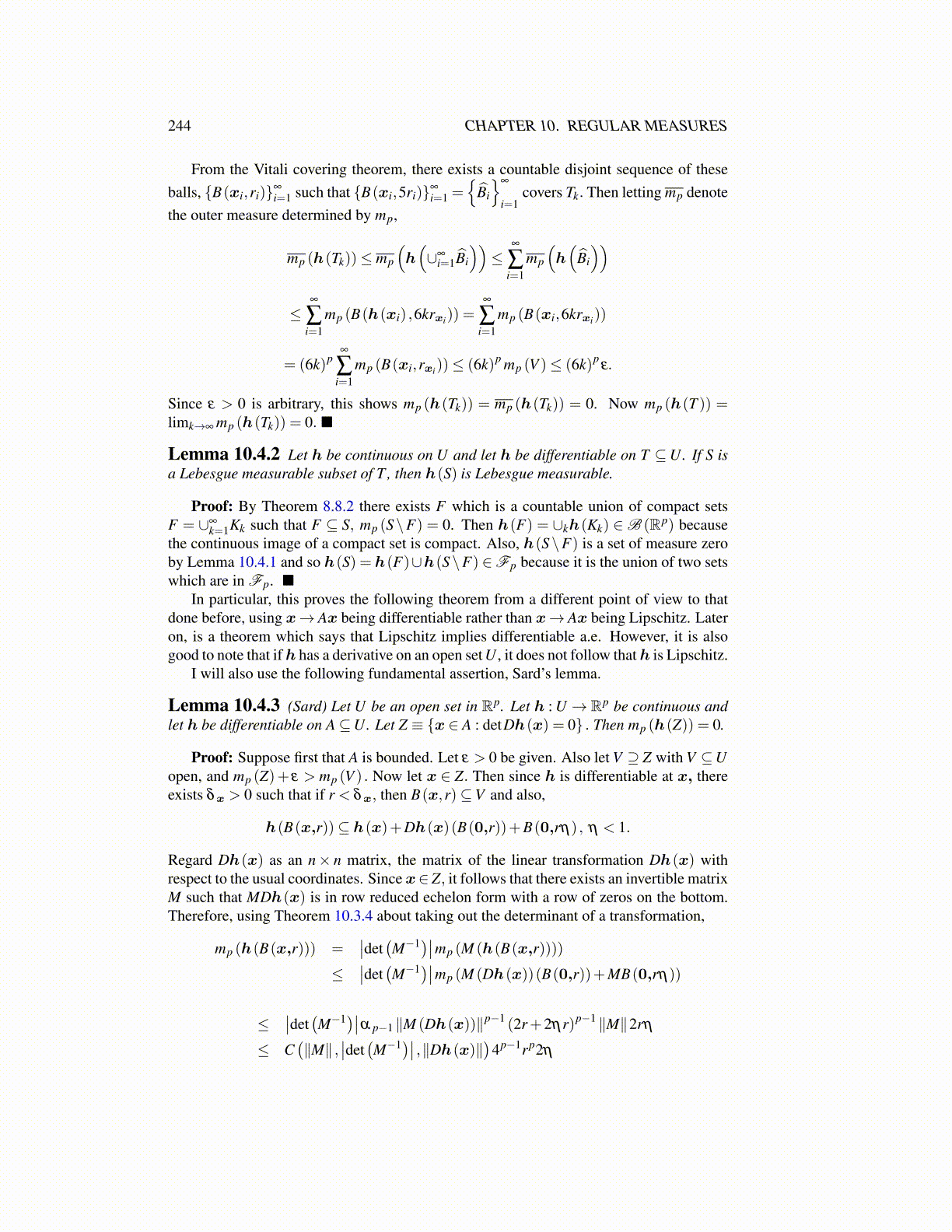
244 CHAPTER 10. REGULAR MEASURES
From the Vitali covering theorem, there exists a countable disjoint sequence of theseballs, {B(xi,ri)}∞
i=1 such that {B(xi,5ri)}∞
i=1 ={
B̂i
}∞
i=1covers Tk. Then letting mp denote
the outer measure determined by mp,
mp (h(Tk))≤ mp
(h(∪∞
i=1B̂i
))≤
∞
∑i=1
mp
(h(
B̂i
))
≤∞
∑i=1
mp (B(h(xi) ,6krxi)) =∞
∑i=1
mp (B(xi,6krxi))
= (6k)p∞
∑i=1
mp (B(xi,rxi))≤ (6k)p mp (V )≤ (6k)pε.
Since ε > 0 is arbitrary, this shows mp (h(Tk)) = mp (h(Tk)) = 0. Now mp (h(T )) =limk→∞ mp (h(Tk)) = 0. ■
Lemma 10.4.2 Let h be continuous on U and let h be differentiable on T ⊆U. If S isa Lebesgue measurable subset of T , then h(S) is Lebesgue measurable.
Proof: By Theorem 8.8.2 there exists F which is a countable union of compact setsF = ∪∞
k=1Kk such that F ⊆ S, mp (S\F) = 0. Then h(F) = ∪kh(Kk) ∈B (Rp) becausethe continuous image of a compact set is compact. Also, h(S\F) is a set of measure zeroby Lemma 10.4.1 and so h(S) = h(F)∪h(S\F) ∈Fp because it is the union of two setswhich are in Fp. ■
In particular, this proves the following theorem from a different point of view to thatdone before, using x→ Ax being differentiable rather than x→ Ax being Lipschitz. Lateron, is a theorem which says that Lipschitz implies differentiable a.e. However, it is alsogood to note that if h has a derivative on an open set U , it does not follow that h is Lipschitz.
I will also use the following fundamental assertion, Sard’s lemma.
Lemma 10.4.3 (Sard) Let U be an open set in Rp. Let h : U → Rp be continuous andlet h be differentiable on A⊆U. Let Z ≡ {x ∈ A : detDh(x) = 0} . Then mp (h(Z)) = 0.
Proof: Suppose first that A is bounded. Let ε > 0 be given. Also let V ⊇ Z with V ⊆Uopen, and mp (Z)+ ε > mp (V ) . Now let x ∈ Z. Then since h is differentiable at x, thereexists δx > 0 such that if r < δx, then B(x,r)⊆V and also,
h(B(x,r))⊆ h(x)+Dh(x)(B(0,r))+B(0,rη) , η < 1.
Regard Dh(x) as an n× n matrix, the matrix of the linear transformation Dh(x) withrespect to the usual coordinates. Since x∈ Z, it follows that there exists an invertible matrixM such that MDh(x) is in row reduced echelon form with a row of zeros on the bottom.Therefore, using Theorem 10.3.4 about taking out the determinant of a transformation,
mp (h(B(x,r))) =∣∣det
(M−1)∣∣mp (M (h(B(x,r))))
≤∣∣det
(M−1)∣∣mp (M (Dh(x))(B(0,r))+MB(0,rη))
≤∣∣det
(M−1)∣∣α p−1 ∥M (Dh(x))∥p−1 (2r+2ηr)p−1 ∥M∥2rη
≤ C(∥M∥ ,
∣∣det(M−1)∣∣ ,∥Dh(x)∥
)4p−1rp2η